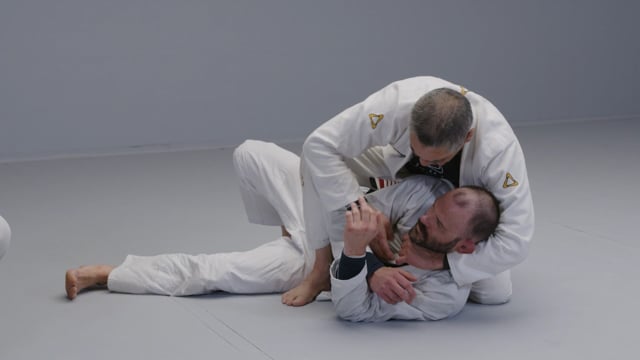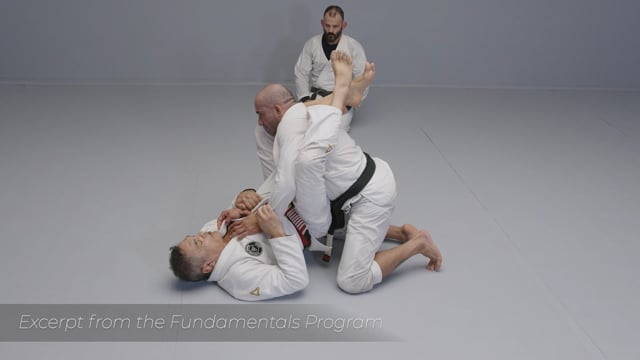Yes, you don't even remember, but you were born playing guard, kicking about. If you stopped training for a while, it was your mistake. After all, the position, the eternal life saver of jiujitsu fighters on the streets and in the ring, was already established a long time ago. Years. Centuries.
Whoever looks at the masterpiece "Fight at the Cock Inn," a painting from 1777 by the immense painter Francisco de Goya, can observe the following scene: a bar fight, Spaniards hitting each other on all sides. In the center of the canvas, a guy in top position seems to be... well, passing the guard! Sure, it takes a certain love and jiujitsu and a dash of imagination to see this.
But creativity has always been linked to the guard. In an obscure book lost on a dusty shelf, there is a theory that African pygmies already valued, in hand-to-hand combat, the technique of keeping your legs between the ferocious aggressor and your nose. Kicking about, therefore, was always a life saver.
It was the Japanese jiujitsu that was reborn Brazilian, however, that best explored and valued the guard. On the mats, from Count Combat until today, the art of defending oneself on the ground and equalizing the weight of the aggressor and the defender was revolutionized.
As the judoka and expert finisher Flávio Canto says, the role of jiujitsu and the exchange between fighters was fundamental:
"I think Brazilian jiujitsu is exceptional. Its great contribution to worldwide ne-waza, and to the guard game, was to combine such a large number of practitioners with Brazilian creativity. That's how a whole range of unprecedented positions and situations emerged, which are now well established," says the Athens-2004 Olympic medalist. "Spider guard, for example, I have never seen before anywhere; it is a Brazilian jiujitsu thing. Another positive aspect of the art is to land doing guard and always facing the opponent; after all, nobody has an eye in the back of the head. It is this reflex that many judokas and wrestlers lack."
When he arrived in Brazil at the beginning of the 20th century, the Japanese Count Combat brought not only an effective leg game, learned through great effort by the young Carlos Gracie. He also passed on oriental lessons of discipline, health and honor that would permeate the family's history forever. Seeking to spread the art that gave him so many benefits, Carlos began to make history—and to write the guard's history as well. "He was the first Westerner to overcome an Eastern champion, in 1924, at a time when the Japanese thought Westerners were degenerates," recalls his son Rilion Gracie, considered the best guard player in the family. It was against Geo Omori, when the grandmaster pulled guard and applied a tomoe-nage—the balloon sweep—and fell mounted. Gracie then snapped the arm of the brave Japanese, who ordered the fight to continue, his veins bulging.
Later, in 1951, when the younger brother Helio Gracie closed the guard and, with his broad forearms, put the excellent judoka Jukio Kato to sleep in a collar choke, the art of the guard was undeniable. And ready to continue being developed, thanks to the creativity and sweat of many students and champions.
Each new faithful adopter of the guard went on to give their contribution, laying a stone here, some cement there, and helping to build the reputation of the guard as the essence of jiujitsu. The metaphor of construction, in fact, is not gratuitous. Within the Gracie family, the guard position is seen as a fortress that gives security to the fighter. You don't necessarily lose the war if you don't have a solid wall—but it sure helps. Especially so you can position your offensive arsenal from the top of it. The guard is the jiujitsu fighter's fortress. Do you prefer to fight with your walls open or closed?
In 1950s Rio, jiujitsu was already famous for giving any skinny guy the chance to be his own fortress. It was Carlson Gracie's turn to contribute to the guard—first in his fighting days, then with his students. Competitive to the extreme, Carlson started to specialize his students in order to win championships. That's when he would roar, "You're either a guard player, or you're a passer."
"There is a myth that Carlson only trained guard passers. But besides De la Riva, he had another student, Marcelo Duque Estrada, the Octopus-Man, today a judge, who had an incredibly elastic guard," comments the coral-belt master Redley Vigio. "Cássio Cardoso, for example, was well rounded. But his guard indeed left an impression: every jiujitsu student should watch his hour-long fight against Marcelo Behring, in 1988. Marcelo also had a monster guard, and the ending is sensational. It's all on YouTube."
Until 1994, it was not enough for the bottom fighter to reverse the fight and fall on top to earn the sweep points—he had to do so using only recognizable moves, such as the tomoe-nage, or the foot to the groin, or the classic scissors, among a few others. With the rule reform, proposed by the Brazilian Jiujitsu Confederation, it was enough for the guard players to pass and stay on top to get two points. They were now prestigious. And ready to surprise.
"The guard, which until 1994 was more of a shield, became the weapon that could decide the fight. I remember seeing Renzo Gracie in the gym, in 1987, doing spider guard for the first time. As he was a very resourceful guy, he used it very little in competitions. I, a skinny dude, fell in love with the invention and surprised a lot of people," remembers Vinicius Magalhães, known as Draculino. The guard players' show was getting started, with a lot of creativity and adaptations of classic levers.
If you want to be a good guard player, therefore, never forget to build a solid foundation, so your wall doesn't collapse. Insist on the basics, and then your body type and your type of play will certainly define what is ideal for you. There; now you are ready to kick about—this time with all class.
Study the guard basics with this excerpt from one of Master Rickson's many great classes. Oss! To watch the complete class click here.


Comments
👏👏👏
💯
👏